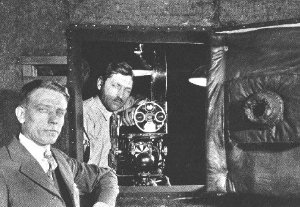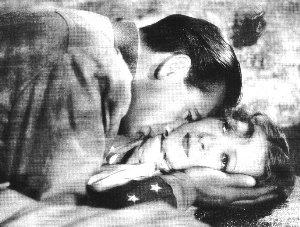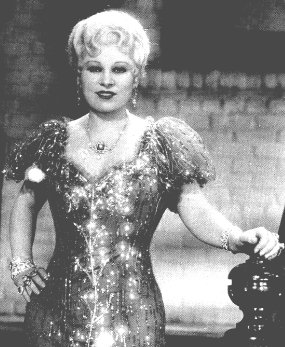  |
  |
'Talkies' helped boost the movie industry during the early days of the Great Depression. Although attendance was up in 1930, profits fell drastically in 1931. Sagging attendance and expensive sound retooling put on the financial squeeze. In 1929 four of the largest studios( Paramount, Fox, Loew's(MGM), and Warner Bros. ) had enlisted help from Wall Street for their retooling expenses, which ran into the millions. By 1933 several studios were in severe financial trouble. The former industry leader, Paramount, was in bankruptcy. Both RKO and Universal were in receivership and Fox was reorganizing( It would be taken over by the smaller Twentieth Century within 2 years. ). Columbia, Warners, MGM and United Artists were solvent but had massive layoffs.
In July of 1930 the studios were anxious to avoid a patents war over the competing sound systems. Warners had Vitaphone, Fox had Movietone, and RCA(in control of RKO) used Photophone. In 1930 they uniformly adopted the Western Electric sound-on-film format.
Improvements were made as some of the logistical problems in dealing with sound began to be overcome. The camera was freed from the soundproof 'icebox' so that shots could become more dynamic. Boom arms and multidirectional microphones were also employed. Finally the camera was free to move again.

Censorship was still a hot issue. The religious organizations' pressure on the movie industry became especially pronounced when supported by the wealthy William Randolph Hearst. In addition, Senator S.W.Brookhart introduced a bill to put the movies under the jurisdiction of the Federal Trade Commission.
The pressure forced action that Will Hays felt sure would help the industry clean up its act. Central to the discussion was Martin Quigley, publisher of the popular Motion Picture Herald. He helped mediate a solution between the Catholic Church and the movie company presidents. Father Daniel Lord, a St. Louis University professor, helped draft The Production Code in February of 1930. By March it was adopted by the Association of Motion Picture Producers and the Motion Picture Producers and Distributors of America.
In October of 1930, Hays hired Joe Breen as the public relations man for the Production Code. A Catholic who was not afraid of confrontation, Breen would be located with the Hays Office's west coast operations. A wave of public debate over the moral value of such early decade gangster films as Little Caesar, 1930 and The Public Enemy, 1931 along with the usual complaints about sexual explicitness were temporarily quelled.
Hays' west coast office had a difficult task and operated with officials of varying style. In the late 1920s it was Colonel Jason Joy who read scripts and advised producers of possible problems. He came up with a list of 'Don'ts and Be Carefuls' which were detested and mostly ignored. James Wingate, a former school superintendent and educational specialist brought a more uncompromising style to the office in the early 1930s.

The way the approval system worked made it easy for producers to get around a demanding personality like Wingate. If he were to deny a certificate to a movie, the producer could always appeal. In an appeal a three member 'Hollywood Jury' comprised of producers themselves(with their own vested interests) would rule on a film's passability. Wingate's power waned as films like A Farewell to Arms, 1932 could get passed by the 'Hollywood Jury' after being denied certification by him.

By 1933 the depression had forced the studios to look for a box office success by whatever means they could. When Paramount released the Mae West vehicle She Done Him Wrong in February of 1933, the architect of the Production Code, Father Daniel Lord, was inflammed. However, as the film cost under $250,000 to produce and brought in over 10 times that in North America alone, it was easy to see why Paramount pushed it through.
In November of 1933 church leaders formed 'The Episcopal Committee on Motion Pictures'. In the same month Hays effectively demoted Wingate and put Breen, with his political savvy and connections to the church heirarchy, in charge of the Studio Relations Office. By April of 1934 the Episcopal Committee told the American Catholic Bishops that it planned to form a Legion of Decency to clean pictures up. The movement gained momentum and in June of 1934 Hays acted with major changes to his administration that completely altered the films of the 1930s.
The Studio Relations Office became the 'Production Code Administration' with Joe Breen as the Production Code Administrator. All scripts had to be passed by Breen with appeals going to the Association board in New York rather than the 'Hollywood Jury'. A $25,000 fine would be levied for any picture released violating the code. In effect, a film could not be profitably released without the Production Code seal as theater circuits were controlled by members of the Motion Picture Association.

The lack of strong enforcement of the Production Code between the years 1930 and 1934 makes the films of these years more daring, risque, and controversial than the later films of the decade. My favorite films and stars of this period are explored in the next section.

| |
 | |
 | <--next |
 |